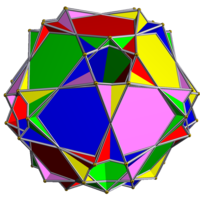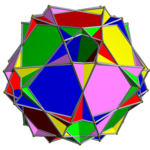Loading AI tools
Polyhedral compound From Wikipedia, the free encyclopedia
In geometry, this uniform polyhedron compound is a composition of 5 octahemioctahedra, in the same vertex arrangement as in the compound of 5 cuboctahedra.
The topic of this article may not meet Wikipedia's notability guideline for numbers. (July 2019) |
| Compound of five octahemioctahedra | |
|---|---|
 | |
| Type | Uniform compound |
| Index | UC61 |
| Polyhedra | 5 octahemioctahedra |
| Faces | 40 triangles, 20 hexagons |
| Edges | 120 |
| Vertices | 60 |
| Symmetry group | icosahedral (Ih) |
| Subgroup restricting to one constituent | pyritohedral (Th) |
There is some controversy on how to colour the faces of this polyhedron compound. Although the common way to fill in a polygon is to just colour its whole interior, this can result in some filled regions hanging as membranes over empty space. Hence, the "neo filling" is sometimes used instead as a more accurate filling. In the neo filling, orientable polyhedra are filled traditionally, but non-orientable polyhedra have their faces filled with the modulo-2 method (only odd-density regions are filled in). In addition, overlapping regions of coplanar faces can cancel each other out. Usage of the "neo filling" makes the compound of five octahemioctahedra a hollow polyhedron compound.[1]
 Traditional filling |
 "Neo filling" |
Seamless Wikipedia browsing. On steroids.
Every time you click a link to Wikipedia, Wiktionary or Wikiquote in your browser's search results, it will show the modern Wikiwand interface.
Wikiwand extension is a five stars, simple, with minimum permission required to keep your browsing private, safe and transparent.